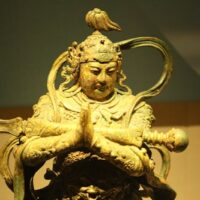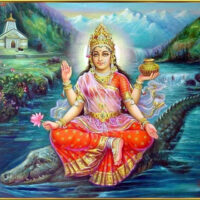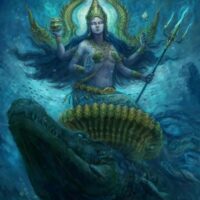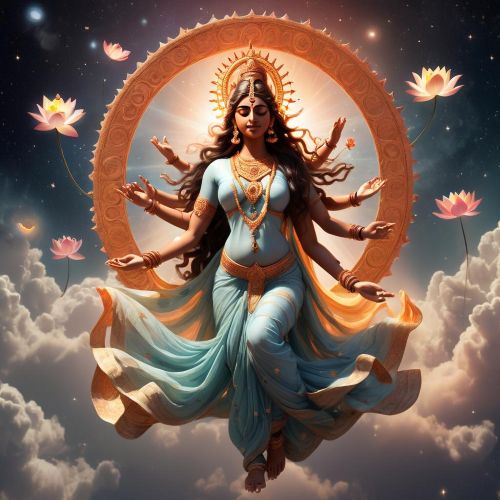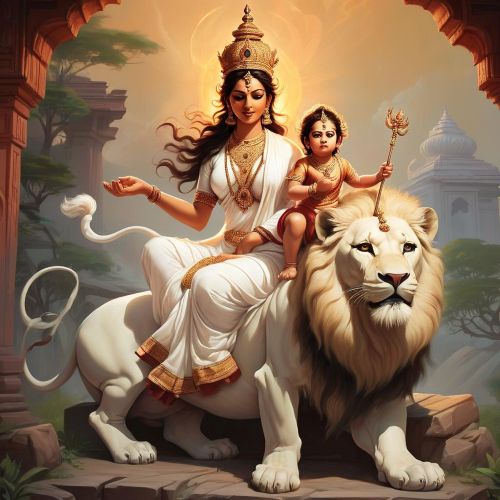Danu : The Mother of Asuras
Listen
At a glance
| Description | |
|---|---|
| Origin | Indian Mythology |
| Classification | Gods |
| Family Members | Prajapati (Father), Kashyapa (Husband). Danavas (Children) |
| Region | India, Indonesia |
| Associated With | Primordial Waters, Creation, Asuras |
Danu
Introduction
Danu is one of the most intriguing figures in Hindu mythology, remembered as the primordial mother of the Danavas, a clan of powerful beings who often stood in opposition to the Devas. Her name originates from the Sanskrit term “dānu,” meaning fluid, rain, or drop, reflecting her deep association with water and the primeval forces of creation. References to Danu appear in the Rigveda, where she is identified as the mother of the asura Vritra, the great serpent slain by Indra. Over time, her role expanded in Puranic texts, where she is described as one of the daughters of Prajapati Daksha, the consort of the sage Kashyapa, and the progenitor of a hundred formidable sons.
Though she is not as frequently worshipped as goddesses like Aditi or Saraswati, Danu’s mythological presence is profound. She represents a raw, untamed aspect of the cosmos—an elemental mother whose offspring embody power, defiance, and mystery. Much like water itself, Danu symbolizes creation, continuity, and at times, chaos. Her presence in Indo-European traditions, where names of rivers such as Danube, Don, and Dnieper trace their roots back to the same word, reveals her archetypal importance across cultures.
Physical Traits
Hindu texts rarely provide detailed descriptions of Danu’s physical form. Instead, her image is drawn from her symbolic associations. As a goddess of primordial waters, she is often envisioned as an ethereal matron draped in flowing garments resembling waves. Her presence is imagined as majestic and nurturing, yet she carries an aura of untamed energy, representing both fertility and destruction.
Artists and poets who attempt to capture Danu’s essence usually portray her with long, rippling hair reminiscent of rivers, her attire adorned with aquatic motifs, and her bearing dignified and maternal. She represents the archetype of the cosmic mother—fluid, formless, and eternal. In this sense, Danu is less a physical figure and more a cosmic force personified, embodying the dual nature of water: sustaining life yet capable of unleashing chaos.
Family
Danu’s place within the genealogies of Hindu mythology underscores her importance as a matriarch. She is described as the daughter of Prajapati Daksha and his wife Panchajani, linking her to one of the oldest creator lineages. Her union with the sage Kashyapa gave rise to the Danavas, a powerful race of beings often described as adversaries of the gods.
According to the Padma Purana, Danu bore a hundred sons, among whom Vipracitti emerged as a leader. Other notable figures include Svarbhanu, Vritra, and Puloman, all of whom appear in myths of conflict with the Devas. Unlike her sister Diti, whose children are known as the Daityas, Danu’s progeny are recognized as Danavas, making them a distinct but equally formidable branch of the Asura race.
Through her children, Danu’s influence pervades many of the great mythological battles, from Indra’s slaying of Vritra to the wars between gods and Asuras described in the Mahabharata. Even Bali, one of the greatest Asura kings, is counted among the Danavas. Her role as their mother places her at the heart of the cosmic struggle between divine order and primordial chaos.
Other names
The name Danu itself holds great symbolic weight. In Sanskrit, it refers to water or fluid, which perfectly aligns with her role as a goddess of primordial creation. The same linguistic root can be found in the Avestan word dānu, meaning river, and in the names of major rivers across Europe and Asia, such as the Danube, Dnieper, Don, and Dniestr. These linguistic parallels suggest that the reverence of Danu, or deities like her, may have extended across ancient Indo-European cultures.
In Balinese Hinduism, she is honored as Dewi Danu, a goddess of lakes and rivers, particularly associated with Lake Batur. This shows how her worship traveled and transformed across regions while retaining her elemental character. Comparative mythology has also linked her to similar mother-goddess archetypes such as the Celtic Danu, mother of the Tuatha Dé Danann, and even to figures like Tiamat of Mesopotamian lore, who likewise embodies chaotic waters and motherhood of powerful beings.
Powers and Abilities
Danu’s powers are rooted in her identity as a primordial mother. She is regarded as a source of creation, giving birth to races of beings who shaped mythological history. Her connection to water symbolizes fertility, renewal, and abundance, but also turbulence and destruction. Unlike goddesses of war or wisdom who directly act in myth, Danu’s influence is exercised through her children, who inherited her immense powers.
The Danavas were known for their siddhis—supernatural abilities such as shape-shifting, invisibility, and mastery of illusion. This reflects Danu’s own association with maya, or magical illusion, described in texts like the Brahmanda Purana. Her lineage produced extraordinary figures such as Maya Danava, the master architect who designed the celestial palace at Indraprastha, the flying cities of Tripura, and even authored the Surya Siddhanta, a foundational text in Indian astronomy. These feats indicate that Danu’s progeny carried within them not just destructive might, but also profound wisdom and technological knowledge.
Thus, Danu’s powers extend beyond nurturing creation—her legacy is also tied to knowledge, innovation, and transformation, qualities inherited by her children who continually challenged the gods and reshaped the mythological world.
Modern Day Influence
Though Danu is not widely worshipped in contemporary Hindu practice, her influence persists in multiple forms. In regions like Bali, rituals at lakes and rivers invoke Dewi Danu for fertility, prosperity, and protection of crops, showing how her elemental role remains relevant in agricultural societies. Similarly, in Nepal, the Danu River continues to echo her name, linking geography with mythology.
In modern spirituality, Danu is reimagined as a goddess of feminine power, cycles of nature, and the wisdom of water. She is honored in rituals focused on fertility, transformation, and balance between order and chaos. Beyond religion, her presence resonates in literature, art, and even fantasy genres, where writers and creators draw upon her archetype of the mysterious water-mother who births mighty forces.
Academic interest in Danu also continues to grow. Scholars of comparative mythology explore her connections with Indo-European deities, while translations of the Rigveda and Puranas ensure that her story remains alive. Platforms dedicated to mythology, such as Mythlok, highlight her relevance in understanding the interconnectedness of global mythologies.
Danu’s legacy, therefore, endures not as a distant memory, but as a living archetype that inspires both spiritual practice and creative imagination. She embodies the paradox of water—life-giving yet untamable—and reminds us of the eternal cycles of creation and dissolution.
Related Images
Source
Hinduism StackExchange. (2018, April 29). Danu is the predecessor of the race of Danavas (demons). Retrieved from https://hinduism.stackexchange.com/questions/27256/danu-is-the-predecessor-of-the-race-of-danavas-demons
History Cooperative. (n.d.). Danu: The Mother Goddess in Irish Mythology. Retrieved from https://historycooperative.org/danu/
KidZone.ws. (n.d.). Celtic Goddess, Danu. Retrieved from https://www.kidzone.ws/mythology/celtic/danu.htm
NamuWiki. (n.d.). Danu (Indian mythology). Retrieved from https://en.namu.wiki/w/%EB%8B%A4%EB%88%84(%EC%9D%B8%EB%8F%84%20%EC%8B%A0%ED%99%94)
The Celtic Journey. (n.d.). Danu. Retrieved from https://thecelticjourney.wordpress.com/tag/danu/
Centre of Excellence. (n.d.). Danu in Celtic Mythology: Myths, Powers, and Symbols. Retrieved from https://www.centreofexcellence.com/danu-in-celtic-mythology/
Myth and Folklore Wiki. (n.d.). Danu (Irish goddess). Retrieved from https://mythus.fandom.com/wiki/Danu_(Irish_goddess)
Hindupedia. (2023, April 7). Dānava. Retrieved from https://hindupedia.com/en/D%C4%81nava
New Indian Express. (2023, September 9). Epics for children | Mythical beings, Danavas. Retrieved from https://www.newindianexpress.com/lifestyle/spirituality/2023/Sep/09/epics-for-children-mythical-beingsdanavas-2612692.html
Kate Wood. (2012, October 16). Pantheon of Godesses: Danu. Retrieved from https://katewoodauthor.wordpress.com/2012/10/16/pantheon-of-godesses-danu/
Medium. (2024, September 16). The Danish Connection to Hindu Goddess Danu’s Exiled Sons from India. Retrieved from https://medium.com/@selfsutras/the-danish-connection-to-hindu-goddess-danus-exiled-sons-from-india-2121dfb12ba8
Frequently Asked Questions
What is lorem Ipsum?
I am text block. Click edit button to change this text. Lorem ipsum dolor sit amet, consectetur adipiscing elit. Ut elit tellus, luctus nec ullamcorper mattis, pulvinar dapibus leo.
What is lorem Ipsum?
I am text block. Click edit button to change this text. Lorem ipsum dolor sit amet, consectetur adipiscing elit. Ut elit tellus, luctus nec ullamcorper mattis, pulvinar dapibus leo.
What is lorem Ipsum?
I am text block. Click edit button to change this text. Lorem ipsum dolor sit amet, consectetur adipiscing elit. Ut elit tellus, luctus nec ullamcorper mattis, pulvinar dapibus leo.
What is lorem Ipsum?
I am text block. Click edit button to change this text. Lorem ipsum dolor sit amet, consectetur adipiscing elit. Ut elit tellus, luctus nec ullamcorper mattis, pulvinar dapibus leo.
What is lorem Ipsum?
I am text block. Click edit button to change this text. Lorem ipsum dolor sit amet, consectetur adipiscing elit. Ut elit tellus, luctus nec ullamcorper mattis, pulvinar dapibus leo.


